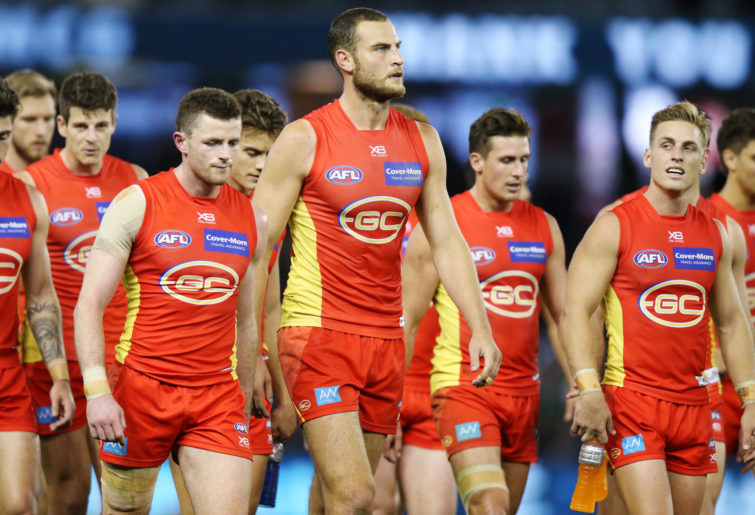The crucial cogs of AFL's Round 7: Which players need to be the difference makers?
We’re taking a look at one player from each team that needs to make a difference this week, starting with the ANZAC Day games.
The Gold Coast is better suited for an AFL expansion team than Tasmania.
It’s also better suited than half of the suburban teams in Melbourne, but their history is irreplaceable.
However, we cannot ignore that the Suns are the laughing stock of the AFL.
Since entering the league in 2011, the Suns have won just 47 out of a possible 198 games, which looks even worse when compared to the 79 games won by 2012 expansion team Greater Western Sydney.
But just because their on-field performances are a laughing stock, it doesn’t mean the Gold Coast market isn’t one of the most appealing in Australia.
The difference in on-field success between the two expansion sides is obvious, but while the Suns continue to struggle and GWS flourish, the similarities in fan engagement show a team on the Gold Coast has the potential to work extremely well.
Despite finishing 18th with a 3-19 record, Gold Coast only averaged 850 less in attendance than the finals-bound Giants.
The Suns averaged 11,417 people at home, including a home game in Townsville drawing just 7243. While the Giants, who had their fifth consecutive season with a winning record, only managed an average attendance of 12,267.
But the focus isn’t on the past seasons, the focus is on the future, which is why the AFL believed both locations were suitable for expansion.
Since joining the league in 2011, the Gold Coast Suns have helped contribute to growing the game in Queensland with AFL Queensland participation figures increasing from 130,000 in 2011 to 265,000 in 2018.
The rapidly increasing growth in Queenslanders playing football, especially on the Gold Coast, has been the most successful part of the Suns’ nine-year history.

(Photo by Michael Dodge/Getty Images)
While the Suns don’t have the biggest fan base (ranked 18th in 2019 with 13,649 members), their market brings a potential to the AFL that is second to none in Australia.
Home to over 600,000 people, the Gold Coast’s population is significantly less than major Australian cities but has been the fastest growing Australian city since 2001.
Five years from now, the Gold Coast’s population is set to eclipse the 750,000 mark and with the city’s population growing at historic pace alongside record participation numbers for AFL in Queensland, the Gold Coast has the potential to become a sustainable football city in a rugby league-mad state.
Obviously, it won’t be an overnight success, and with membership totals stagnant around 14,000 since 2011, the only positive in the Suns’ nine seasons seems to be the off-field growth.
But the AFL’s focus is on the future and the finances, and though the Suns’ on-field performances have hurt their financial growth, the Gold Coast will soon become a viable AFL city, which will translate into on-field success.
Patience is often something that fans don’t have, but most importantly for the Suns, the AFL have proven that they are patient.
In 2018, the AFL contributed $23.7 million to the Suns’ finances, backing up a $24.7 million grant in 2017, showing that the AFL are committed to the process of building football on the Gold Coast.
Unlike a team in Tasmania, though, the city of the Gold Coast provides the AFL with potential that cannot be replicated.
A Tasmanian AFL side is what plenty of football fans want to see, and while it would be a good move for some, it wouldn’t be a worthy investment for the AFL to make.
The Suns are often ridiculed for their low crowds at Metricon Stadium, but the only Tasmanian-based side that can draw comparisons is the BBL’s Hobart Hurricanes, who averaged 11,348 last season – a season in which they won the minor premiership.
But again, the focus isn’t on the past seasons, the focus is on the future.
A combined population of only 310,000 between Hobart and Launceston – as well as a below-average population growth of 0.29% – means that Tasmania’s market potential as an AFL host is extremely restricted.
Tasmania is also already heavily involved and engaged with the AFL, with 45,000 Tasmanians participating with AFL football in 2018. It is Tasmania’s engagement with the AFL, without having a team, that unfortunately damages their chances the most.
A team in Tasmania could work, but despite people thinking Gold Coast’s on-field performance is enough of a reason to fold or re-locate, a team in Tasmania is not a better option than one on the Gold Coast – and it never will be.
The objective of a team on the Gold Coast was to grow the game in the enticing, untapped Queensland market and, with patience, it will work.
Whereas a team in Tasmania, while being a feel-good story for fans, would not be a smart business decision for the AFL.
And unfortunately for Tasmanians, the AFL is a business.